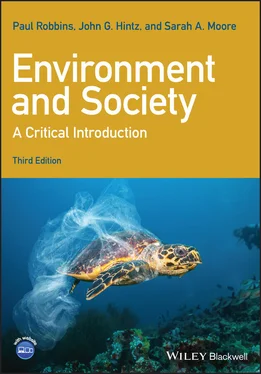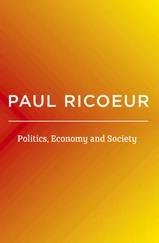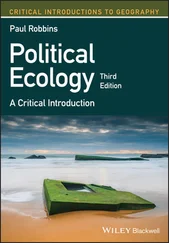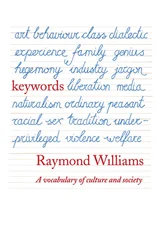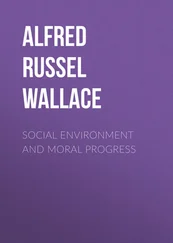This process, where scarcity is relieved by laws of supply and demand, which together govern and sustain the relationship of people to nature, is what resource economists and geographers call the “ market response model” (Figure 3.2). Here, price signals are translated into adaptations by rational and creative people in the market, providing abundance under conditions of scarcity (or mitigate environmental risk, see Box 3.1). It is this logic that apparently allowed Simon to prevail over Ehrlich in their 1980 bet.
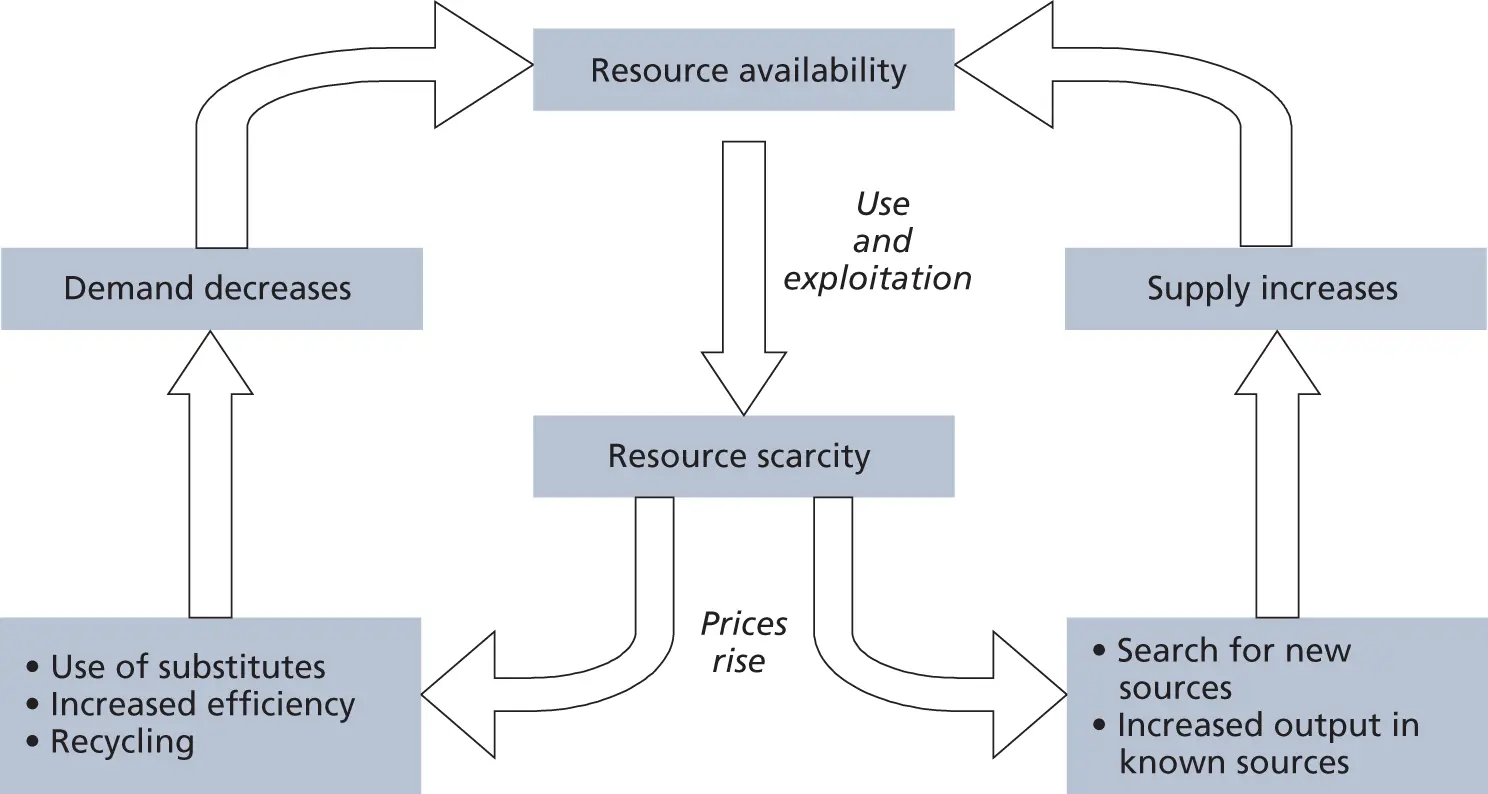
Figure 3.2 The market response model. In theory, scarcity of environmental goods and services sets into motion a series of adaptations to rising prices, actually resulting in increasing resource availability. Source : Adapted from Rees, J. (1990). Natural Resources: Allocation, Economics, and Policy . New York: Routledge, p. 39.
Box 3.11Environmental Solution? Insurance Addresses Climate Change
Most global industries have been slow to respond to, or even acknowledge, global climate change. There are good reasons for this. Changing production systems to mitigate climate change by greening the workplace, using alternative energy sources, and creating products with lower climate footprints can be expensive. Acknowledging climate change can cut into the corporate bottom line.
There are some industries, however, where addressing climate change represents an immediate opportunity to avoid lost revenue, or even to make money. The most notable example is insurance, the world’s largest industry, with $4.6 trillion in revenues annually. Insurance is different from other industries since it sells financial products to mitigate risk. Essentially, insurers make the greatest profit when buyers feel a need to protect themselves from risks (like flooding, drought or bad weather), but where these unfortunate events are unlikely to happen. Insurance companies, in other words, need to be able to predict how risky situations are, quantify that risk, and reduce that risk for their buyers wherever possible, so that the insurer collects the most premiums, but pays expensive claims as infrequently as possible.
As such, the insurance industry has a deep interest in understanding, measuring, planning for, and reducing the rate of climate change. This is first because insurers set their rates and calculations based on records from the past, records of decreasing utility in a changing world. If insurers know that a catastrophic flood happens every century, for example, they can calculate how to set rates or whether to insure a high-risk property. But with climate change, the future frequency of these kinds of floods is harder to predict or determine. Insurers need to support good climate science to plan for a changing risk profile. Insurers are also interested in helping their buyers to change their exposure to risk, doing things like protecting their property or using alternative or diverse energy sources, to make them more resilient to changing conditions.
So what is the insurance industry actually doing? First, it is providing new kinds of products to buyers, which favor things like green building practices and decreased energy usage. Insurers worldwide, for example, have introduced 65 different insurance products in the past few years, specifically favoring renewable energy systems. Second, it is paying claims out favorably to buyers who experienced losses (in a major storm, flooding, or drought event) where the buyer rebuilds in a way that is more resilient to future risks, and less likely to suffer losses.
There are, of course, some things that insurance cannot do. Some risks may become so great that insurers will simply no longer cover them. Crop losses in the Midwestern United States, for example, may become so frequent and devastating that insurers may leave that market altogether. So too, insurers have a limited influence on large-scale transformation of national energy systems and transportation networks, which are major drivers of greenhouse gas emissions. Nevertheless, it is clear that thinking about the environment through the lens of financial risk shows that climate change is a major market challenge and an opportunity.
Managing Environmental Bads: The Coase Theorem
Environmental problems and issues are not always about the scarcity of discrete, individual things, like copper or oil. How can market thinking apply to all environmental objects and conditions (e.g. swimmable streams, diverse rainforests, clean beaches), not just traditional commodities (e.g. milk, tungsten, codfish)? In theory, if human activity makes clean air or water scarce, and I value clean air or water, I should be willing to pay for remediation of the situation. If someone else is polluting that air or water, however, and I am experiencing the effects of that deterioration downstream or further away, how could my willingness to pay be realized?
Coase TheoremA thesis based in neoclassical economics, holding that externalities (e.g. pollution) can be most efficiently controlled through contracts and bargaining between parties, assuming the transaction costs of reaching a bargain are not excessive
Many economists have addressed this problem, but the most prominent solution came from a Nobel laureate in economics, Ronald H. Coase. In 1960, Coase laid out one of the founding propositions of contemporary economics (often called the “ Coase theorem”), which held that in cases of competing interests, the most efficient outcomes will occur through bargaining between property owners (Coase 1960).
What Coase proposes is that many environmental problems can be solved most effectively through contracts. Consider, for example, a family living in a beautiful valley spot in Montana next to a cattle ranch. As it turns out, the cattle ranch is both noisy and somewhat smelly. Such an effect, where one person’s economic activity comes at the expense of another, is called an externality, and as we will see later in this chapter and in Chapter 4, it is common to environmental problems. Such situations also cause lots of nasty arguments in Montana, moreover.
How can such a situation be regulated? One solution might be for the county government to ban ranching in the area, in order to protect homeowners, causing the ranch to shut down. Another would be to make it clear that cattle are more important than housing in rural areas, thus shutting down housing developments in the area. Alternatively, complex rules could be designed, telling developers how to build smell- and sound-proof housing and cattle ranchers how to move and keep their cattle more quietly. None of these solutions is necessarily socially fair or just to one side or the other. The last solution, while perhaps fairer, may be economically inefficient and far more expensive than the other alternatives. Who pays for these redesigning efforts and on what terms? What approach would produce an optimal outcome?
In Coase’s way of thinking, it would be better to let the two parties sort the problem out themselves through contracts and, in the process, discover the real costs and values of ranching, mountain views, and cattle smells. By coming to terms with one another, whatever they decide is always the most efficient outcome, no matter what the initial rights are in the situation.
If the family moved in after the ranch had long been in business, for example, or if the family had no legal right to limit the rancher’s actions, they would simply have to tolerate it, or absorb the cost of the smell by paying some higher price for property elsewhere, and moving far away from the ranch. The difference in the price of their current house and the new one reflects how much the people are willing to pay to not live around cattle. Perhaps, however, the cost of the new home is far higher than the cost they might be able to pay the rancher for simply moving the cattle shed to the other side of the property. By paying the rancher a lower sum, the family maintains its pretty view and reduces the smell while offsetting the rancher’s costs for doing so. In that case, the price of the environmental nuisance is discovered through the negotiation between the two parties (rather than by relying on a regulator), and everyone experiences an optimal outcome.
Читать дальше
